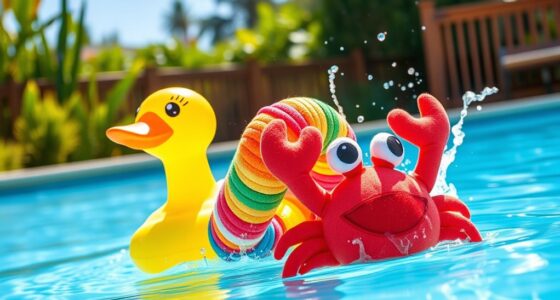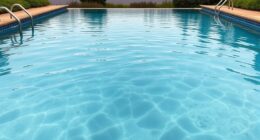To deal with mustard algae, start by identifying its dull yellow or brown slime on the pool surfaces, especially in shaded areas. Use a stiff brush or algae scraper to physically remove it, and perform water changes and regular cleaning. Maintain proper chemical balance and circulation, shock the pool regularly, and lower phosphates to prevent recurrence. If you’re still facing issues, keep going to learn proven tips for eliminating persistent algae.
Key Takeaways
- Identify mustard algae by its dull yellow-green color and slimy texture on pool surfaces.
- Scrub affected areas thoroughly with brushes and algae scrapers to physically remove algae.
- Perform regular water testing, maintain proper chemical balance, and increase chlorine levels to prevent growth.
- Use shock treatments and algaecides specifically formulated for mustard algae, repeating as necessary.
- Improve circulation by running pumps at least 8 hours daily and cleaning filters to reduce algae-spreading zones.
Recognizing the Signs of Mustard Algae
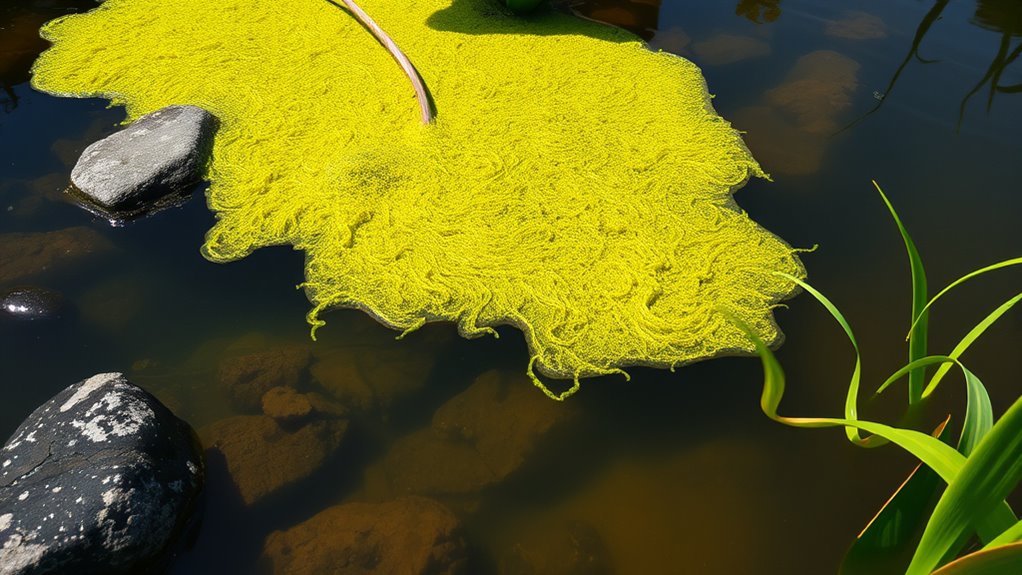
Recognizing the signs of mustard algae is vital for effective treatment. It usually appears as a dull yellow, yellow-green, or brown layer on your pool surfaces, often mistaken for dirt, sand, or pollen. Its color can vary based on water chemistry and sunlight. The algae feels slimy and smooth, similar to fine sand or dirt, and clings stubbornly to walls, floors, and corners—especially in shaded areas or spots with poor circulation. When brushed, it puffs into a cloud and resists removal, lingering despite cleaning efforts. Mustard algae tends to spread quickly and can be found near steps, behind ladders, or around light fixtures. Its persistence and resistance to typical sanitizers make early detection vital for effective control. Mustard algae is resistant to chlorine, which makes it particularly challenging to eliminate once established.
Effective Methods for Removing Mustard Algae
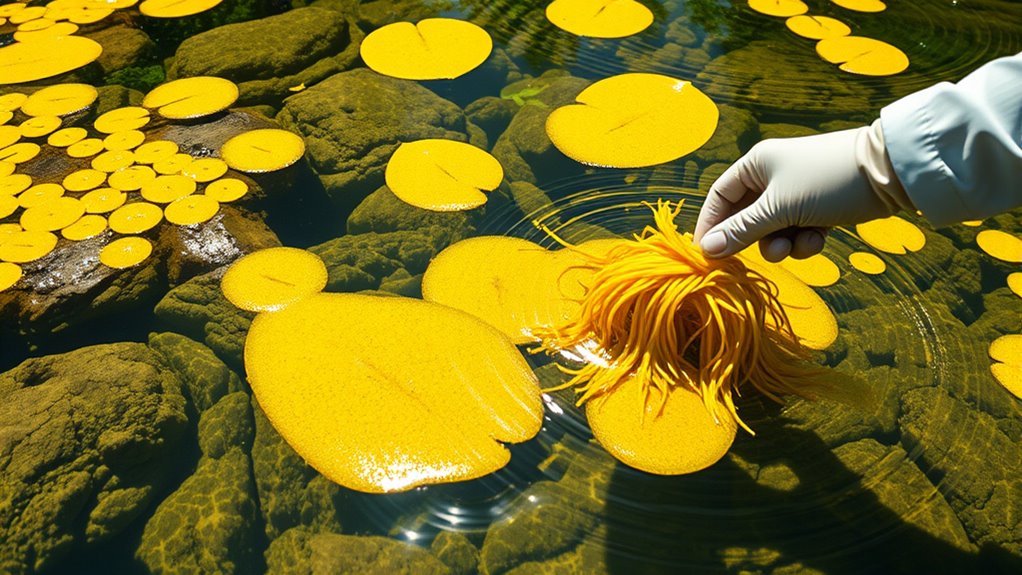
To effectively remove mustard algae from your aquarium or pool, manual cleaning techniques are essential. Use a toothbrush to scrub algae from surfaces like rocks, driftwood, and filters. An algae scraper or magnetic scraper works well for cleaning glass tanks, helping lift algae without damaging surfaces. Repeat manual removal regularly and perform 50% water changes to gradually reduce algae density. Complete eradication isn’t necessary; removing most of the algae slows its growth considerably. After cleaning, monitor surfaces for remaining algae and repeat as needed until control is achieved. These physical methods are effective in loosening and removing mustard algae, especially when combined with consistent maintenance routines. Staying diligent with manual removal prevents algae from reestablishing, keeping your aquatic environment clean and healthy.
Preventive Measures to Stop Future Outbreaks
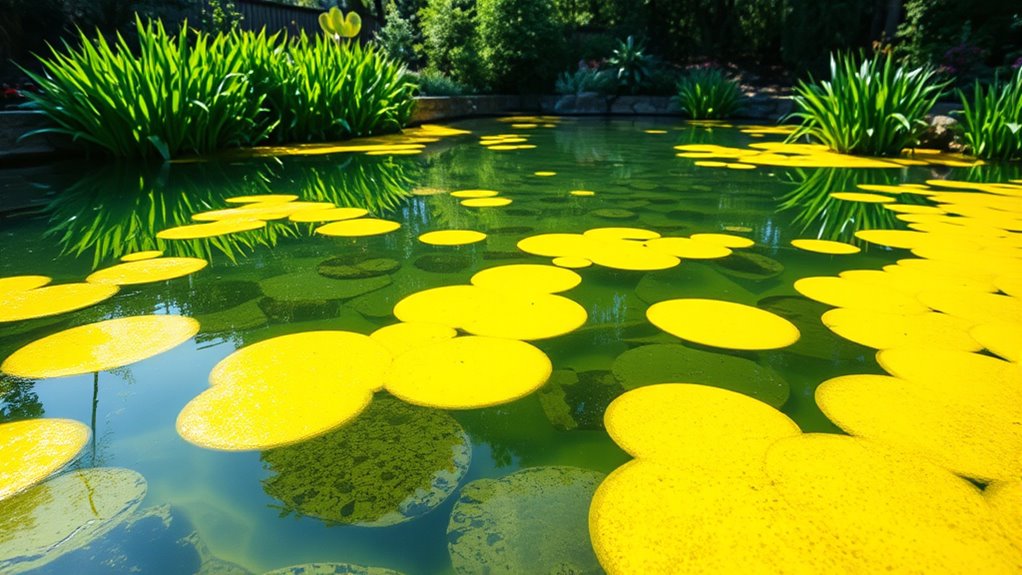
Maintaining proper chemical balance is essential to preventing mustard algae outbreaks. Test your pool water chlorine levels 2–3 times weekly, increasing testing during hot weather or heavy use to ensure sanitizer effectiveness. Keep pH and alkalinity within recommended ranges; imbalances weaken chlorine and promote algae growth. Monitor and lower phosphates, which feed algae, to inhibit proliferation. Use shock treatments proactively every few weeks during peak season to maintain sanitation. After chemical adjustments, wait at least an hour and retest to confirm stability. Optimize circulation by running the pump at least 8 hours daily, and backwash filters regularly. Brush and vacuum surfaces weekly, especially in low-flow or shaded areas, to physically remove spores. Additionally, maintaining proper circulation and filtration efficiency helps prevent dead zones where algae can thrive. These measures create a hostile environment for mustard algae, preventing future outbreaks.
Proper Pool Maintenance for Long-Term Control

Consistent pool maintenance is key to controlling mustard algae over the long term. To keep your pool clear, focus on these three essentials:
- Maintain chemical balance by regularly testing pH (7.2–7.6), alkalinity (80–120 ppm), and chlorine (1–3 ppm). Use shock treatments and algaecides specifically for mustard algae to ensure spores are eliminated. Proper chemical balance also discourages algae from taking hold in the first place. Chemical stability helps prevent algae growth and keeps your water safe. Regular testing ensures your water remains within optimal ranges for effective algae prevention.
- Perform thorough brushing and cleaning weekly, especially in problem areas, then vacuum to remove loosened algae and debris. Clean pool equipment and toys with a diluted bleach solution.
- Optimize circulation and filtration by running your pump 8–12 hours daily, cleaning filters regularly, and addressing low-flow zones to prevent stagnant water where algae thrive. Monitoring your filter performance can help identify when maintenance or upgrades are needed to maintain proper water flow.
When to Seek Professional Help

Even with diligent pool maintenance, some mustard algae problems don’t improve despite your best efforts. If algae remains after multiple shock treatments, brushing, and increasing sanitizer levels, it’s time to call in professionals. Persistent algae that resists chemical treatments and reappears quickly signals a deeper issue, possibly with water chemistry or circulation. Frequent fluctuations in pH and chlorine, high phosphate levels, or inadequate filtration require expert testing and balancing. If your pool’s circulation system has dead zones or equipment issues, professionals can diagnose and fix these problems efficiently. When algae coverage becomes widespread, affecting pool usability and appearance, or if over-the-counter products fail, seeking professional help ensures effective, long-term solutions. Don’t hesitate to get expert advice when algae becomes unmanageable. Mustard algae’s resistance to chlorine can make it especially challenging to eliminate without specialized knowledge and equipment. Additionally, addressing underlying water chemistry issues is crucial to preventing future outbreaks.
Frequently Asked Questions
Can Mustard Algae Survive in Saltwater Pools?
Yes, mustard algae can survive in saltwater pools. Its resistance to chlorine and other sanitizers, thanks to protective compounds, permits it to persist despite saltwater chlorination. You might notice yellow or gold patches on your pool surfaces, and it can quickly return after brushing or partial removal. To combat this, you need to use specialized algaecides, maintain proper sanitizer levels, and ensure good circulation and filtration.
How Long Does It Take to Completely Eradicate Mustard Algae?
It typically takes 5 to 7 days to completely eradicate mustard algae, but some cases may extend up to 10 days if the algae is severe or treatment is delayed. You’ll notice improvement within 24 to 48 hours after shock and brushing. Keep up with daily brushing, vacuuming, and filter cleaning, and monitor the water’s clarity and chemistry. Persistent algae might require repeat treatments, so stay vigilant until the pool is clear and algae-free.
Are There Natural or Organic Treatments Effective Against Mustard Algae?
You can’t fight algae with a quick fix, so persistence is key. Natural treatments like barley straw extracts release compounds that inhibit algae growth, while hydrogen peroxide acts as a gentle oxidizer to kill algae cells. Botanical algaecides and beneficial bacteria promote ecological control, and maintaining proper water chemistry supports these methods. Regular brushing, vacuuming, and sun exposure further enhance organic control, making natural solutions a viable option for tackling mustard algae effectively.
Can Mustard Algae Cause Health Issues for Swimmers?
Yes, mustard algae can cause health issues for swimmers. While the algae itself isn’t directly harmful, it fosters bacteria like E. coli, which can lead to skin rashes, eye irritation, ear infections, and gastrointestinal problems. Swimming in algae-contaminated water increases your risk of infections and illnesses. To protect yourself, make sure the pool is properly sanitized, maintained, and free of algae before swimming.
What Are the Best Practices for Preventing Mustard Algae in Hot Tubs?
To prevent mustard algae in your hot tub, you should maintain proper water chemistry by keeping pH between 7.4 and 7.6 and sanitizer levels around 4 ppm chlorine. Regularly brush and vacuum the surfaces, keep filters clean, and make certain good circulation throughout the tub. Use algaecides or algaestats consistently, and perform shock treatments if algae appear. Consistent maintenance stops algae from taking hold and keeps your hot tub clean and safe.
Conclusion
Now that you know how to spot and remove mustard algae, you’re equipped to keep your pool clear and inviting. While DIY methods work well, sometimes professional help is needed to guarantee complete eradication. Staying vigilant and maintaining proper pool care can prevent future outbreaks. It’s about balancing effort and ease, action and patience. With the right approach, your pool remains a invigorating oasis, free from stubborn algae and ready for enjoyment whenever you are.




